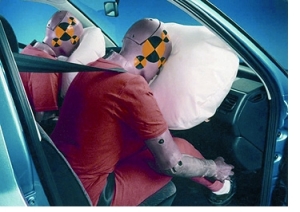 There’s no question that advances in automotive safety technology have made the time we spend behind the wheel less dangerous. But, in the case of air bags the safety system can cause it’s own damage. Considering that air bags deploy at up to 200 miles an hour, and use nitrogen to do so, drivers sitting too close to the steering wheel can be seriously hurt. The following is a list offered by the National Highway Traffic Safety Administration to keep you and your loved ones from incurring unnecessary air bag injuries.
There’s no question that advances in automotive safety technology have made the time we spend behind the wheel less dangerous. But, in the case of air bags the safety system can cause it’s own damage. Considering that air bags deploy at up to 200 miles an hour, and use nitrogen to do so, drivers sitting too close to the steering wheel can be seriously hurt. The following is a list offered by the National Highway Traffic Safety Administration to keep you and your loved ones from incurring unnecessary air bag injuries.
Child Safety Points
- Children 12 and under should ride buckled up in a rear seat.
- Infants in rear facing child safety seats should NEVER ride in the front seat of a vehicle with a passenger side air bag.
- Small children should ride in a rear seat in child safety seats approved for their age and size .
- If a child over one year old must ride in the front seat with a passenger side air bag, put the child in a front facing child safety seat, a booster seat, or a correct fitting lap/shoulder belt– AND move the seat as far back as possible.
Adult Safety Points
- Everyone should buckle up with both lap and shoulder belts on every trip. Air bags are supplemental protection devices .
- The lap belt should be worn under the abdomen and low across the hips. The shoulder portion should come over the collar bone away from the neck and cross over the breast bone. The shoulder belt in most new cars can be adjusted on the side pillar to improve fit.
- Driver and front passenger seats should be moved as far back as practical, particularly for shorter statured people.
Source: www.nhtsa.gov
 If your vehicle is equipped with an airbag we suggest you read this post immediately. The National Highway Traffic Safety Administration says it has upped to nearly 8-million the number of vehicles that may be affected by faulty airbags built by Takata. Caranddriver.com says the airbags have the potential to inflate improperly, resulting in the shrapnel-like shooting of metal fragments. The NHTSA is providing a list of potentially affected vehicles but says that list may change as more information becomes available. We advise running your vehicle’s VIN through the NHTSA’s database to see whether it falls under the recall, and then signing up for alerts so as to stay informed. You can also check your manufacturer’s website for more information.
If your vehicle is equipped with an airbag we suggest you read this post immediately. The National Highway Traffic Safety Administration says it has upped to nearly 8-million the number of vehicles that may be affected by faulty airbags built by Takata. Caranddriver.com says the airbags have the potential to inflate improperly, resulting in the shrapnel-like shooting of metal fragments. The NHTSA is providing a list of potentially affected vehicles but says that list may change as more information becomes available. We advise running your vehicle’s VIN through the NHTSA’s database to see whether it falls under the recall, and then signing up for alerts so as to stay informed. You can also check your manufacturer’s website for more information.